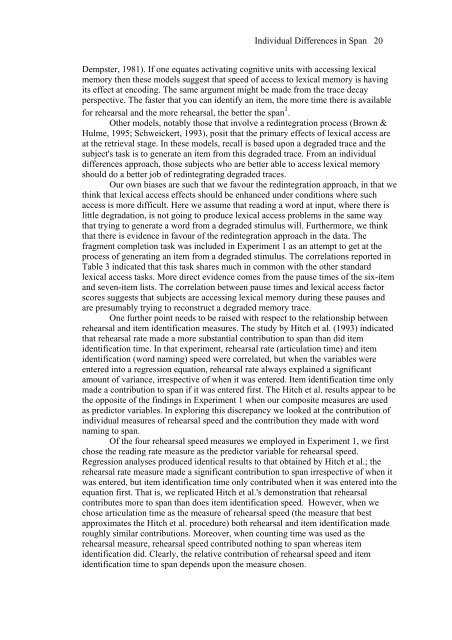Individual Differences in Span 1 Individual Differences in Memory ...
Individual Differences in Span 1 Individual Differences in Memory ...
Individual Differences in Span 1 Individual Differences in Memory ...
You also want an ePaper? Increase the reach of your titles
YUMPU automatically turns print PDFs into web optimized ePapers that Google loves.
<strong>Individual</strong> <strong>Differences</strong> <strong>in</strong> <strong>Span</strong> 20<br />
Dempster, 1981). If one equates activat<strong>in</strong>g cognitive units with access<strong>in</strong>g lexical<br />
memory then these models suggest that speed of access to lexical memory is hav<strong>in</strong>g<br />
its effect at encod<strong>in</strong>g. The same argument might be made from the trace decay<br />
perspective. The faster that you can identify an item, the more time there is available<br />
for rehearsal and the more rehearsal, the better the span 1 .<br />
Other models, notably those that <strong>in</strong>volve a red<strong>in</strong>tegration process (Brown &<br />
Hulme, 1995; Schweickert, 1993), posit that the primary effects of lexical access are<br />
at the retrieval stage. In these models, recall is based upon a degraded trace and the<br />
subject's task is to generate an item from this degraded trace. From an <strong>in</strong>dividual<br />
differences approach, those subjects who are better able to access lexical memory<br />
should do a better job of red<strong>in</strong>tegrat<strong>in</strong>g degraded traces.<br />
Our own biases are such that we favour the red<strong>in</strong>tegration approach, <strong>in</strong> that we<br />
th<strong>in</strong>k that lexical access effects should be enhanced under conditions where such<br />
access is more difficult. Here we assume that read<strong>in</strong>g a word at <strong>in</strong>put, where there is<br />
little degradation, is not go<strong>in</strong>g to produce lexical access problems <strong>in</strong> the same way<br />
that try<strong>in</strong>g to generate a word from a degraded stimulus will. Furthermore, we th<strong>in</strong>k<br />
that there is evidence <strong>in</strong> favour of the red<strong>in</strong>tegration approach <strong>in</strong> the data. The<br />
fragment completion task was <strong>in</strong>cluded <strong>in</strong> Experiment 1 as an attempt to get at the<br />
process of generat<strong>in</strong>g an item from a degraded stimulus. The correlations reported <strong>in</strong><br />
Table 3 <strong>in</strong>dicated that this task shares much <strong>in</strong> common with the other standard<br />
lexical access tasks. More direct evidence comes from the pause times of the six-item<br />
and seven-item lists. The correlation between pause times and lexical access factor<br />
scores suggests that subjects are access<strong>in</strong>g lexical memory dur<strong>in</strong>g these pauses and<br />
are presumably try<strong>in</strong>g to reconstruct a degraded memory trace.<br />
One further po<strong>in</strong>t needs to be raised with respect to the relationship between<br />
rehearsal and item identification measures. The study by Hitch et al. (1993) <strong>in</strong>dicated<br />
that rehearsal rate made a more substantial contribution to span than did item<br />
identification time. In that experiment, rehearsal rate (articulation time) and item<br />
identification (word nam<strong>in</strong>g) speed were correlated, but when the variables were<br />
entered <strong>in</strong>to a regression equation, rehearsal rate always expla<strong>in</strong>ed a significant<br />
amount of variance, irrespective of when it was entered. Item identification time only<br />
made a contribution to span if it was entered first. The Hitch et al. results appear to be<br />
the opposite of the f<strong>in</strong>d<strong>in</strong>gs <strong>in</strong> Experiment 1 when our composite measures are used<br />
as predictor variables. In explor<strong>in</strong>g this discrepancy we looked at the contribution of<br />
<strong>in</strong>dividual measures of rehearsal speed and the contribution they made with word<br />
nam<strong>in</strong>g to span.<br />
Of the four rehearsal speed measures we employed <strong>in</strong> Experiment 1, we first<br />
chose the read<strong>in</strong>g rate measure as the predictor variable for rehearsal speed.<br />
Regression analyses produced identical results to that obta<strong>in</strong>ed by Hitch et al.; the<br />
rehearsal rate measure made a significant contribution to span irrespective of when it<br />
was entered, but item identification time only contributed when it was entered <strong>in</strong>to the<br />
equation first. That is, we replicated Hitch et al.'s demonstration that rehearsal<br />
contributes more to span than does item identification speed. However, when we<br />
chose articulation time as the measure of rehearsal speed (the measure that best<br />
approximates the Hitch et al. procedure) both rehearsal and item identification made<br />
roughly similar contributions. Moreover, when count<strong>in</strong>g time was used as the<br />
rehearsal measure, rehearsal speed contributed noth<strong>in</strong>g to span whereas item<br />
identification did. Clearly, the relative contribution of rehearsal speed and item<br />
identification time to span depends upon the measure chosen.
















